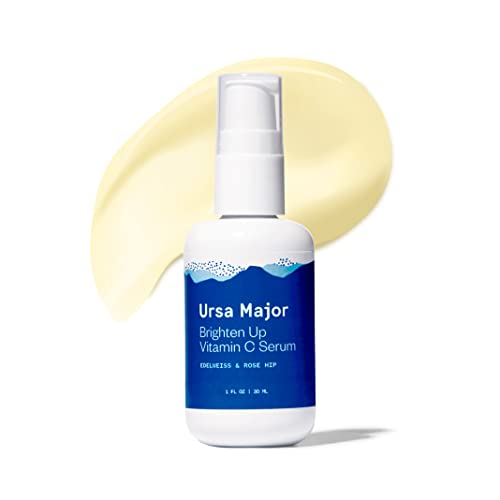
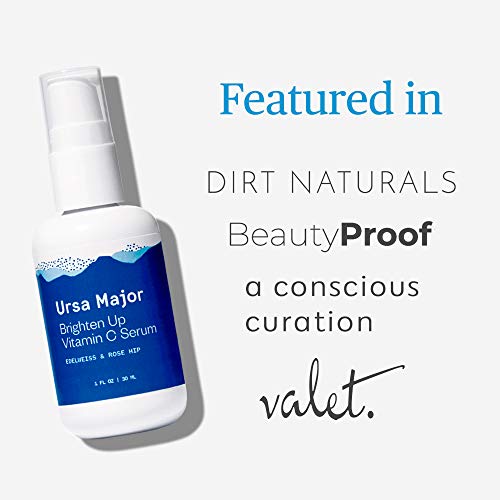
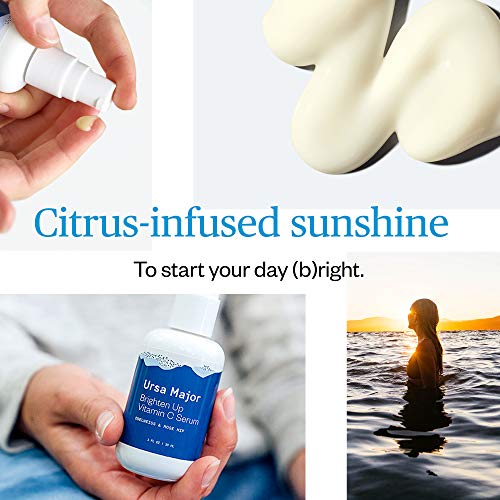
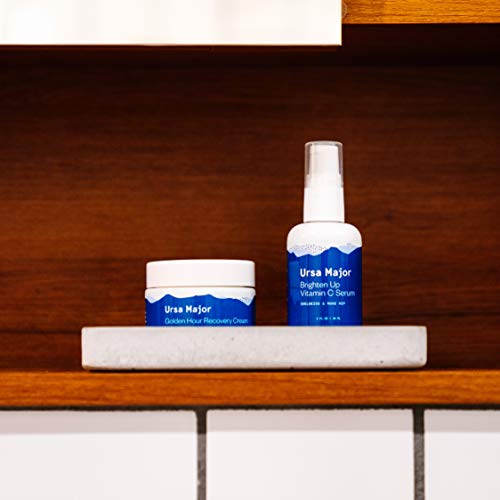
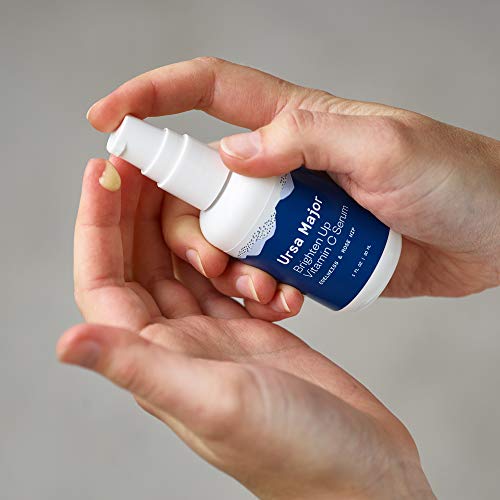
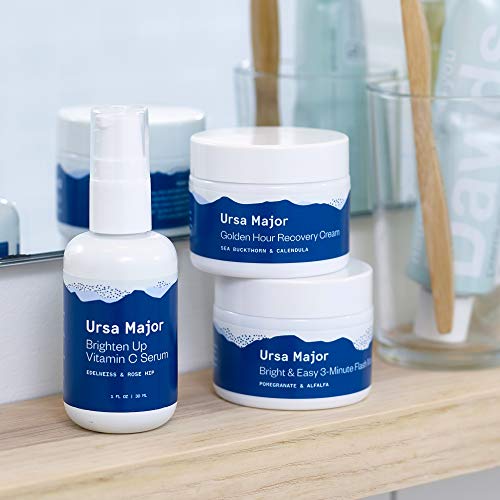
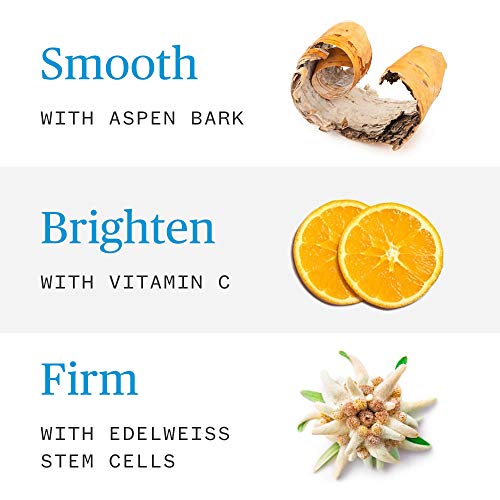
Ursa Major Face Serum - Revitalizes Dull Skin, Targets Wrinkles, Vegan, 1oz


Rosa Damascena Extract
High RiskRosa damascena extract is an extract of the rose species, primarily used in cosmetics for its fragrance and potential skin benefits. It is often incorporated into formulations for its soothing properties and is associated with aromatherapy applications.
Sustai Insights
Rosa damascena extract offers functional benefits such as fragrance enhancement and potential skin soothing effects, appealing to consumers seeking natural ingredients. However, it is associated with a high allergenic potential, and while it has low concerns regarding carcinogenicity and reproductive toxicity, it faces regulatory restrictions in verified products. Environmental risks include possible pollutants, and due to its high allergenic concerns, the overall risk assessment is high, warranting cautious use and consideration of alternatives.
Lactic Acid, L
High RiskLactic acid is an organic acid commonly used in cosmetics and skincare products as an exfoliant and pH regulator. It helps in improving skin texture and hydration by promoting the shedding of dead skin cells and enhancing moisture retention.
Sustai Insights
Lactic acid offers functional benefits as an effective exfoliant and moisturizer, contributing to improved skin appearance. However, it poses potential risks, including skin irritation and enhanced absorption, which may lead to adverse effects. Regulatory bodies have noted use restrictions due to these concerns. Overall, the ingredient is considered high risk, necessitating cautious usage, particularly for sensitive skin. Alternatives like glycolic acid may provide similar benefits with potentially lower irritation.
Rosmarinus Officinalis (Rosemary) Leaf Extract
Medium RiskRosemary leaf extract is produced from the leaves of the Rosmarinus officinalis plant. It is commonly used in cosmetic formulations for its potential antioxidant properties and fragrance. The extract may also contribute to the preservation of products due to its antimicrobial characteristics.
Sustai Insights
Rosemary leaf extract offers functional benefits such as antioxidant and antimicrobial properties, which can enhance product stability and shelf-life. It is generally considered low risk for carcinogenicity and reproductive toxicity, but it carries a moderate potential for allergic reactions. Environmentally, it poses low risk with no significant pollutant or bioaccumulation concerns. Regulatory bodies have not placed significant restrictions on its use, although some verified products cannot contain certain concentrations. Overall, the ingredient's risk level is medium, necessitating careful usage practices to mitigate allergic responses.
Citrus Aurantium Dulcis (Orange) Peel Oil
Medium RiskCitrus aurantium dulcis (orange) peel oil is derived from the peel of oranges and is commonly used in cosmetic and personal care products for its fragrance and potential skin benefits. It is known for its aromatic properties and is often included in formulations aimed at enhancing scent profiles.
Sustai Insights
Citrus aurantium dulcis (orange) peel oil offers functional benefits such as providing a pleasant scent and potential antimicrobial properties. However, it poses a high allergy risk and may cause skin irritation in sensitive individuals. Environmental concerns include moderate persistence and potential to contribute to pollution. Regulatory warnings indicate restrictions on use in certain products. Overall, the risk level is assessed as medium, and users are advised to practice caution, particularly those with known allergies. Alternatives like sweet orange essential oil may provide similar benefits with potentially lower risks.
Bisabolol
Medium RiskBisabolol is a scent ingredient naturally occurring in various plants, particularly in chamomile. It is primarily used in cosmetics for its fragrance and potential skin-soothing properties, contributing to the overall sensory experience of personal care products.
Sustai Insights
Bisabolol offers functional benefits as a fragrance component and may provide skin-soothing effects. It is generally recognized for its low carcinogenic risk and low developmental toxicity, though moderate concerns exist regarding allergy potential. Bisabolol is also subject to certain restrictions in verified products. Environmental impacts are minimal, but it should be used with caution in sensitive populations. Overall, it poses a medium risk level based on current scientific understanding.
Coconut Alcohol
Low RiskCoconut alcohol is a mixture of fatty alcohols derived from coconut oil. It serves primarily as an emulsifier and thickening agent in cosmetic formulations, enhancing texture and stability.
Sustai Insights
Coconut alcohol provides functional benefits as an effective emulsifier and thickener, contributing to product stability. It is generally regarded as low risk for health concerns, including carcinogenicity, allergies, and reproductive toxicity. Environmental risks are minimal, with no significant pollutant or bioaccumulation potential noted. Regulatory assessments indicate no substantial restrictions. Safe usage practices should be followed, and alternatives like plant-based emulsifiers may offer similar benefits with potentially enhanced sustainability. Overall, the ingredient has a low risk profile.
Ascorbic Acid (Vitamin C)
Low RiskAscorbic acid (Vitamin C) is a naturally occurring antioxidant essential for various biological functions, including collagen synthesis and immune response. It is commonly used in cosmetic and food products for its preservative properties and ability to enhance skin brightness.
Sustai Insights
Ascorbic acid provides functional benefits as an effective antioxidant and preservative, contributing to skin health and product stability. It is generally recognized as safe with low health risks, including minimal concerns for carcinogenicity and allergies. Environmentally, it poses low risks, as it is biodegradable and does not bioaccumulate. Regulatory bodies like the FDA have not imposed significant restrictions on its use. Overall, the ingredient presents a low risk, with safe usage practices ensuring consumer safety, and alternatives such as natural extracts exist for those seeking different formulations.
Citrus Limon (Lemon)
Low RiskCitrus limon, commonly known as lemon, is a citrus fruit used primarily for its juice and zest. It is often included in personal care products for its astringent properties and as a natural fragrance. It is recognized for its potential antioxidant benefits and as a source of vitamin C.
Sustai Insights
Citrus limon offers functional benefits like acting as a natural preservative and providing fragrance in formulations. It is sustainably sourced and biodegradable. Health risks are considered low for carcinogenicity, allergies, and reproductive toxicity. Environmental risks are minimal, with no significant bioaccumulation. Regulatory status is favorable, with no current restrictions noted. Overall, this ingredient poses a low risk, making it a safe choice for consumers.
Sodium Anisate
Low RiskSodium anisate is the sodium salt of p-anisic acid, commonly used as a preservative in various cosmetic and personal care products. It is recognized for its antimicrobial properties, which help to extend the shelf life of products by inhibiting the growth of bacteria and fungi.
Sustai Insights
Sodium anisate serves effectively as a preservative, offering antimicrobial benefits while being biodegradable and potentially sustainably sourced. Health risks are low, with minimal concerns regarding carcinogenicity, allergies, or reproductive toxicity. Environmentally, it poses low risks as it is not bioaccumulative. Regulatory bodies, including the EPA, do not impose significant restrictions on its use. Overall, sodium anisate presents a low risk, making it a favorable choice in formulations, although alternatives should be considered for those seeking greener options.
Hydrogenated Lecithin
Low RiskHydrogenated lecithin is an end-product of the hydrogenation of lecithin, a naturally occurring phospholipid derived from sources like soybeans and egg yolks. It is commonly used as an emulsifier, stabilizing agent, and thickener in various formulations, including food and cosmetic products.
Sustai Insights
Hydrogenated lecithin offers functional benefits as an effective emulsifier, enhancing product texture and stability. It is generally recognized as safe, with low concerns for carcinogenicity, allergies, and reproductive toxicity. Environmental risks are minimal, with no significant evidence of bioaccumulation or pollution. Regulatory bodies do not impose restrictions on its use. Overall, it can be considered low risk, with safe usage practices recommended. Alternatives such as sunflower lecithin may offer similar benefits with different sourcing profiles.
Orange
Low RiskOrange, derived from the fruit of the Citrus sinensis tree, is commonly used in various products for its aromatic properties and as a flavoring agent. It is often employed for its potential to enhance sensory appeal in food and cosmetic formulations.
Sustai Insights
Orange offers functional benefits such as flavor enhancement and fragrance in products. It is generally considered safe with low concerns regarding carcinogenicity, allergies, and reproductive toxicity. Environmental risks are minimal, as it does not significantly contribute to pollution or bioaccumulation. Regulatory bodies have no current restrictions on its use. Overall, orange is assessed to have a low risk profile, making it a viable option in formulations.
Vegetarian Glycerin
Low RiskVegetarian glycerin, also known as glycerol, is a colorless, odorless, and viscous liquid derived from plant sources. It is primarily used as a humectant, solvent, and emollient in various personal care products, helping to retain moisture and improve texture.
Sustai Insights
Vegetarian glycerin offers functional benefits as an effective humectant, promoting hydration and skin smoothness. It is biodegradable and typically sustainably sourced. Health risks associated with glycerin are low, with no significant concerns for carcinogenicity, allergens, or reproductive toxicity. Environmental risks are minimal, and it is not subject to major regulatory warnings. Overall, the risk level for this ingredient is low, making it a safe choice in formulations. Safe usage practices include ensuring proper concentrations in products, and alternatives such as propylene glycol exist but may have differing properties.
Sclerotium Gum
Low RiskSclerotium gum is a polysaccharide gum produced by the fermentation of certain fungi. It serves primarily as a thickening, stabilizing, and gelling agent in various cosmetic formulations, contributing to texture and consistency.
Sustai Insights
Sclerotium gum offers functional benefits as a stabilizer and thickener in cosmetic products. It is considered low risk for health concerns, including carcinogenicity, allergies, and reproductive toxicity. Environmentally, it poses minimal risks and is not known to bioaccumulate. Regulatory agencies have not issued significant warnings, affirming its safety for use. Overall, the risk level associated with sclerotium gum is low, making it a viable ingredient in formulations, with no pressing need for alternatives.
Glyceryl Caprylate
Low RiskGlyceryl caprylate is a monoester of glycerin and caprylic acid, commonly used in cosmetics and personal care products as an emulsifier and skin-conditioning agent. It helps stabilize formulations and improve the texture and feel on the skin.
Sustai Insights
Glyceryl caprylate offers functional benefits as an effective emulsifier and skin-conditioning agent, enhancing product performance. It is biodegradable and considered sustainably sourced. Health risks are low, with minimal concerns regarding carcinogenicity, allergenic potential, and endocrine disruption. Environmental risks are also low, with no significant pollutant or bioaccumulation potential identified. Regulatory status is favorable, with no major restrictions. Overall, glyceryl caprylate maintains a low risk profile, making it a suitable ingredient for use in cosmetic formulations.
Helianthus Annuus (Sunflower) Seed
Low RiskHelianthus annuus (sunflower) seed is derived from the seeds of the sunflower plant and is commonly used in various cosmetic and personal care products. It serves primarily as an emollient and skin conditioning agent, providing moisture and enhancing the texture of formulations.
Sustai Insights
Helianthus annuus (sunflower) seed offers functional benefits, including skin conditioning and moisturizing properties, while being sustainably sourced and biodegradable. Health risks are minimal, with low concerns for carcinogenicity, allergies, and reproductive toxicity. Environmentally, it presents low risks of pollution or bioaccumulation. Regulatory assessments indicate no current restrictions. Overall, it is considered a low-risk ingredient, and safe usage practices should be maintained. Alternative ingredients may include other plant-based oils, but the sunflower seed oil remains a viable option.
Aloe Barbadensis (Aloe Vera) Leaf Extract
Low RiskAloe vera leaf extract is produced from the succulent leaves of the Aloe barbadensis plant. It is commonly used in cosmetic formulations for its moisturizing and soothing properties, making it a popular ingredient in skincare and personal care products.
Sustai Insights
Aloe vera leaf extract offers several functional benefits, including hydration and skin soothing effects, which are well-supported by scientific literature. It is considered to have a low risk for common health concerns such as carcinogenicity, allergies, or reproductive toxicity. Environmentally, it poses minimal risks, with no significant pollutant potential or bioaccumulation reported. Regulatory bodies have not imposed major restrictions, although verified products should not contain certain contaminants. Overall, this ingredient is assessed as low risk, with safe usage practices and the availability of alternative soothing agents if desired.
Xanthan Gum
Low RiskXanthan gum is a polysaccharide, a sugar-based compound produced by the fermentation of glucose or sucrose. It is commonly used as a thickening agent and stabilizer in various food and cosmetic products due to its ability to improve texture and prevent ingredient separation.
Sustai Insights
Xanthan gum serves effectively as a thickener and stabilizer, enhancing product texture and consistency. It is biodegradable and typically derived from renewable sources, supporting sustainability efforts. Health risks are minimal, with low concerns regarding carcinogenicity, allergies, and reproductive toxicity. Environmental impact is similarly low, posing no significant hazards. Regulatory agencies, including the FDA, regard it as safe for use, with no significant restrictions. Overall, xanthan gum is assessed as low risk, making it a suitable ingredient in formulations.
Coconut Alcohol
Low RiskCoconut alcohol is a mixture of fatty alcohols derived from coconut oil. It serves primarily as an emulsifier and thickening agent in cosmetic formulations, enhancing texture and stability.
Sustai Insights
Coconut alcohol provides functional benefits as an effective emulsifier and thickener, contributing to product stability. It is generally regarded as low risk for health concerns, including carcinogenicity, allergies, and reproductive toxicity. Environmental risks are minimal, with no significant pollutant or bioaccumulation potential noted. Regulatory assessments indicate no substantial restrictions. Safe usage practices should be followed, and alternatives like plant-based emulsifiers may offer similar benefits with potentially enhanced sustainability. Overall, the ingredient has a low risk profile.
Ascorbic Acid (Vitamin C)
Low RiskAscorbic acid (Vitamin C) is a naturally occurring antioxidant essential for various biological functions, including collagen synthesis and immune response. It is commonly used in cosmetic and food products for its preservative properties and ability to enhance skin brightness.
Sustai Insights
Ascorbic acid provides functional benefits as an effective antioxidant and preservative, contributing to skin health and product stability. It is generally recognized as safe with low health risks, including minimal concerns for carcinogenicity and allergies. Environmentally, it poses low risks, as it is biodegradable and does not bioaccumulate. Regulatory bodies like the FDA have not imposed significant restrictions on its use. Overall, the ingredient presents a low risk, with safe usage practices ensuring consumer safety, and alternatives such as natural extracts exist for those seeking different formulations.
Citrus Limon (Lemon)
Low RiskCitrus limon, commonly known as lemon, is a citrus fruit used primarily for its juice and zest. It is often included in personal care products for its astringent properties and as a natural fragrance. It is recognized for its potential antioxidant benefits and as a source of vitamin C.
Sustai Insights
Citrus limon offers functional benefits like acting as a natural preservative and providing fragrance in formulations. It is sustainably sourced and biodegradable. Health risks are considered low for carcinogenicity, allergies, and reproductive toxicity. Environmental risks are minimal, with no significant bioaccumulation. Regulatory status is favorable, with no current restrictions noted. Overall, this ingredient poses a low risk, making it a safe choice for consumers.
Sodium Anisate
Low RiskSodium anisate is the sodium salt of p-anisic acid, commonly used as a preservative in various cosmetic and personal care products. It is recognized for its antimicrobial properties, which help to extend the shelf life of products by inhibiting the growth of bacteria and fungi.
Sustai Insights
Sodium anisate serves effectively as a preservative, offering antimicrobial benefits while being biodegradable and potentially sustainably sourced. Health risks are low, with minimal concerns regarding carcinogenicity, allergies, or reproductive toxicity. Environmentally, it poses low risks as it is not bioaccumulative. Regulatory bodies, including the EPA, do not impose significant restrictions on its use. Overall, sodium anisate presents a low risk, making it a favorable choice in formulations, although alternatives should be considered for those seeking greener options.
Rosmarinus Officinalis (Rosemary) Leaf Extract
Medium RiskRosemary leaf extract is produced from the leaves of the Rosmarinus officinalis plant. It is commonly used in cosmetic formulations for its potential antioxidant properties and fragrance. The extract may also contribute to the preservation of products due to its antimicrobial characteristics.
Sustai Insights
Rosemary leaf extract offers functional benefits such as antioxidant and antimicrobial properties, which can enhance product stability and shelf-life. It is generally considered low risk for carcinogenicity and reproductive toxicity, but it carries a moderate potential for allergic reactions. Environmentally, it poses low risk with no significant pollutant or bioaccumulation concerns. Regulatory bodies have not placed significant restrictions on its use, although some verified products cannot contain certain concentrations. Overall, the ingredient's risk level is medium, necessitating careful usage practices to mitigate allergic responses.
Rosa Damascena Extract
High RiskRosa damascena extract is an extract of the rose species, primarily used in cosmetics for its fragrance and potential skin benefits. It is often incorporated into formulations for its soothing properties and is associated with aromatherapy applications.
Sustai Insights
Rosa damascena extract offers functional benefits such as fragrance enhancement and potential skin soothing effects, appealing to consumers seeking natural ingredients. However, it is associated with a high allergenic potential, and while it has low concerns regarding carcinogenicity and reproductive toxicity, it faces regulatory restrictions in verified products. Environmental risks include possible pollutants, and due to its high allergenic concerns, the overall risk assessment is high, warranting cautious use and consideration of alternatives.
Citrus Aurantium Dulcis (Orange) Peel Oil
Medium RiskCitrus aurantium dulcis (orange) peel oil is derived from the peel of oranges and is commonly used in cosmetic and personal care products for its fragrance and potential skin benefits. It is known for its aromatic properties and is often included in formulations aimed at enhancing scent profiles.
Sustai Insights
Citrus aurantium dulcis (orange) peel oil offers functional benefits such as providing a pleasant scent and potential antimicrobial properties. However, it poses a high allergy risk and may cause skin irritation in sensitive individuals. Environmental concerns include moderate persistence and potential to contribute to pollution. Regulatory warnings indicate restrictions on use in certain products. Overall, the risk level is assessed as medium, and users are advised to practice caution, particularly those with known allergies. Alternatives like sweet orange essential oil may provide similar benefits with potentially lower risks.
Bisabolol
Medium RiskBisabolol is a scent ingredient naturally occurring in various plants, particularly in chamomile. It is primarily used in cosmetics for its fragrance and potential skin-soothing properties, contributing to the overall sensory experience of personal care products.
Sustai Insights
Bisabolol offers functional benefits as a fragrance component and may provide skin-soothing effects. It is generally recognized for its low carcinogenic risk and low developmental toxicity, though moderate concerns exist regarding allergy potential. Bisabolol is also subject to certain restrictions in verified products. Environmental impacts are minimal, but it should be used with caution in sensitive populations. Overall, it poses a medium risk level based on current scientific understanding.
Hydrogenated Lecithin
Low RiskHydrogenated lecithin is an end-product of the hydrogenation of lecithin, a naturally occurring phospholipid derived from sources like soybeans and egg yolks. It is commonly used as an emulsifier, stabilizing agent, and thickener in various formulations, including food and cosmetic products.
Sustai Insights
Hydrogenated lecithin offers functional benefits as an effective emulsifier, enhancing product texture and stability. It is generally recognized as safe, with low concerns for carcinogenicity, allergies, and reproductive toxicity. Environmental risks are minimal, with no significant evidence of bioaccumulation or pollution. Regulatory bodies do not impose restrictions on its use. Overall, it can be considered low risk, with safe usage practices recommended. Alternatives such as sunflower lecithin may offer similar benefits with different sourcing profiles.
Orange
Low RiskOrange, derived from the fruit of the Citrus sinensis tree, is commonly used in various products for its aromatic properties and as a flavoring agent. It is often employed for its potential to enhance sensory appeal in food and cosmetic formulations.
Sustai Insights
Orange offers functional benefits such as flavor enhancement and fragrance in products. It is generally considered safe with low concerns regarding carcinogenicity, allergies, and reproductive toxicity. Environmental risks are minimal, as it does not significantly contribute to pollution or bioaccumulation. Regulatory bodies have no current restrictions on its use. Overall, orange is assessed to have a low risk profile, making it a viable option in formulations.
Vegetarian Glycerin
Low RiskVegetarian glycerin, also known as glycerol, is a colorless, odorless, and viscous liquid derived from plant sources. It is primarily used as a humectant, solvent, and emollient in various personal care products, helping to retain moisture and improve texture.
Sustai Insights
Vegetarian glycerin offers functional benefits as an effective humectant, promoting hydration and skin smoothness. It is biodegradable and typically sustainably sourced. Health risks associated with glycerin are low, with no significant concerns for carcinogenicity, allergens, or reproductive toxicity. Environmental risks are minimal, and it is not subject to major regulatory warnings. Overall, the risk level for this ingredient is low, making it a safe choice in formulations. Safe usage practices include ensuring proper concentrations in products, and alternatives such as propylene glycol exist but may have differing properties.
Sclerotium Gum
Low RiskSclerotium gum is a polysaccharide gum produced by the fermentation of certain fungi. It serves primarily as a thickening, stabilizing, and gelling agent in various cosmetic formulations, contributing to texture and consistency.
Sustai Insights
Sclerotium gum offers functional benefits as a stabilizer and thickener in cosmetic products. It is considered low risk for health concerns, including carcinogenicity, allergies, and reproductive toxicity. Environmentally, it poses minimal risks and is not known to bioaccumulate. Regulatory agencies have not issued significant warnings, affirming its safety for use. Overall, the risk level associated with sclerotium gum is low, making it a viable ingredient in formulations, with no pressing need for alternatives.
Glyceryl Caprylate
Low RiskGlyceryl caprylate is a monoester of glycerin and caprylic acid, commonly used in cosmetics and personal care products as an emulsifier and skin-conditioning agent. It helps stabilize formulations and improve the texture and feel on the skin.
Sustai Insights
Glyceryl caprylate offers functional benefits as an effective emulsifier and skin-conditioning agent, enhancing product performance. It is biodegradable and considered sustainably sourced. Health risks are low, with minimal concerns regarding carcinogenicity, allergenic potential, and endocrine disruption. Environmental risks are also low, with no significant pollutant or bioaccumulation potential identified. Regulatory status is favorable, with no major restrictions. Overall, glyceryl caprylate maintains a low risk profile, making it a suitable ingredient for use in cosmetic formulations.
Helianthus Annuus (Sunflower) Seed
Low RiskHelianthus annuus (sunflower) seed is derived from the seeds of the sunflower plant and is commonly used in various cosmetic and personal care products. It serves primarily as an emollient and skin conditioning agent, providing moisture and enhancing the texture of formulations.
Sustai Insights
Helianthus annuus (sunflower) seed offers functional benefits, including skin conditioning and moisturizing properties, while being sustainably sourced and biodegradable. Health risks are minimal, with low concerns for carcinogenicity, allergies, and reproductive toxicity. Environmentally, it presents low risks of pollution or bioaccumulation. Regulatory assessments indicate no current restrictions. Overall, it is considered a low-risk ingredient, and safe usage practices should be maintained. Alternative ingredients may include other plant-based oils, but the sunflower seed oil remains a viable option.
Lactic Acid, L
High RiskLactic acid is an organic acid commonly used in cosmetics and skincare products as an exfoliant and pH regulator. It helps in improving skin texture and hydration by promoting the shedding of dead skin cells and enhancing moisture retention.
Sustai Insights
Lactic acid offers functional benefits as an effective exfoliant and moisturizer, contributing to improved skin appearance. However, it poses potential risks, including skin irritation and enhanced absorption, which may lead to adverse effects. Regulatory bodies have noted use restrictions due to these concerns. Overall, the ingredient is considered high risk, necessitating cautious usage, particularly for sensitive skin. Alternatives like glycolic acid may provide similar benefits with potentially lower irritation.
Aloe Barbadensis (Aloe Vera) Leaf Extract
Low RiskAloe vera leaf extract is produced from the succulent leaves of the Aloe barbadensis plant. It is commonly used in cosmetic formulations for its moisturizing and soothing properties, making it a popular ingredient in skincare and personal care products.
Sustai Insights
Aloe vera leaf extract offers several functional benefits, including hydration and skin soothing effects, which are well-supported by scientific literature. It is considered to have a low risk for common health concerns such as carcinogenicity, allergies, or reproductive toxicity. Environmentally, it poses minimal risks, with no significant pollutant potential or bioaccumulation reported. Regulatory bodies have not imposed major restrictions, although verified products should not contain certain contaminants. Overall, this ingredient is assessed as low risk, with safe usage practices and the availability of alternative soothing agents if desired.
Xanthan Gum
Low RiskXanthan gum is a polysaccharide, a sugar-based compound produced by the fermentation of glucose or sucrose. It is commonly used as a thickening agent and stabilizer in various food and cosmetic products due to its ability to improve texture and prevent ingredient separation.
Sustai Insights
Xanthan gum serves effectively as a thickener and stabilizer, enhancing product texture and consistency. It is biodegradable and typically derived from renewable sources, supporting sustainability efforts. Health risks are minimal, with low concerns regarding carcinogenicity, allergies, and reproductive toxicity. Environmental impact is similarly low, posing no significant hazards. Regulatory agencies, including the FDA, regard it as safe for use, with no significant restrictions. Overall, xanthan gum is assessed as low risk, making it a suitable ingredient in formulations.
Discover the transformative power of Ursa Major Natural Vitamin C Serum. This brightening formula revitalizes dull skin, smooths tone, and effectively targets wrinkles and sagging while being gentle on sensitive skin.
- Instant Hydration & Brightening: Deeply hydrates and brightens skin with naturally-derived ascorbic acid polypeptide for a luminous glow.
- Clean, Vegan Ingredients: Enriched with soothing aspen bark, protective edelweiss, and hydrating rose hip, free from parabens and toxic chemicals.
- Gentle Yet Effective: Formulated for sensitive skin, ensuring improved absorption and longevity without irritation.
- Featherweight Texture: Lightweight and refreshing citrus aroma makes it perfect for layering under moisturizer or using alone.
- Long-Lasting: Retains potency longer than traditional Vitamin C, offering sustained efficacy for radiant skin.
Embrace a healthier skincare routine that prioritizes both your skin and the planet.
Subscribe & Save with Sustai
- Best Price Guarantee: Always enjoy the lowest prices on sustainable home essentials.
- No Surprises: We’ll notify you before shipping. No hidden fees, ever.
- You’re in Charge: Change, pause, or cancel your subscription anytime with ease.
- Eco-Friendly Deliveries: Our grouped shipments mean less packaging and lower emissions.
Join us on a sustainable journey. Special offers for a limited time! Prices and promotions may change.
Recommended Products
Discover the transformative power of Ursa Major Natural Vitamin C Serum. This brightening formula revitalizes dull skin, smooths tone, and effectively targets wrinkles and sagging while being gentle on sensitive skin.
- Instant Hydration & Brightening: Deeply hydrates and brightens skin with naturally-derived ascorbic acid polypeptide for a luminous glow.
- Clean, Vegan Ingredients: Enriched with soothing aspen bark, protective edelweiss, and hydrating rose hip, free from parabens and toxic chemicals.
- Gentle Yet Effective: Formulated for sensitive skin, ensuring improved absorption and longevity without irritation.
- Featherweight Texture: Lightweight and refreshing citrus aroma makes it perfect for layering under moisturizer or using alone.
- Long-Lasting: Retains potency longer than traditional Vitamin C, offering sustained efficacy for radiant skin.
Embrace a healthier skincare routine that prioritizes both your skin and the planet.

You can have at most 2 Sustainable Steals products in your cart
Customer Reviews
Customers’ View
Customers appreciate the effectiveness and natural formulation of the Ursa Major Brighten Up Vitamin C Serum. Many highlight its ability to provide instant hydration and a satisfying skin feel, making it suitable for sensitive skin. Users note that it absorbs quickly without leaving a greasy residue, contributing to a bright and smooth complexion. Common praises include the serum's lightweight texture and the positive impact on skin brightness, with some mentioning a noticeable glow after use. However, opinions on the scent vary, and while some find it pleasant, others have reported mixed feelings. Overall, customers find this product aligns well with their eco-friendly and health-conscious values, particularly appreciating its non-toxic and cruelty-free formulation.
AI-generated from the text of customer reviewsThis product is rated 4.6 of 5.0 stars.
It has received 9 reviews.




